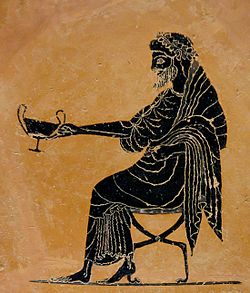
Black-figure pottery painting, also known as the black-figure style or black-figure ceramic, is one of the styles of painting on antique Greek vases. It was especially common between the 7th and 5th centuries BCE, although there are specimens dating as late as the 2nd century BCE. Stylistically it can be distinguished from the preceding orientalizing period and the subsequent red-figure pottery style.

Exekias was an ancient Greek vase painter and potter who was active in Athens between roughly 545 BC and 530 BC. Exekias worked mainly in the black-figure technique, which involved the painting of scenes using a clay slip that fired to black, with details created through incision. Exekias is regarded by art historians as an artistic visionary whose masterful use of incision and psychologically sensitive compositions mark him as one of the greatest of all Attic vase painters. The Andokides painter and the Lysippides Painter are thought to have been students of Exekias.

Euphronios was an ancient Greek vase painter and potter, active in Athens in the late 6th and early 5th centuries BC. As part of the so-called "Pioneer Group,", Euphronios was one of the most important artists of the red-figure technique. His works place him at the transition from Late Archaic to Early Classical art, and he is one of the first known artists in history to have signed his work.
Oltos was a Late Archaic Greek vase painter, active in Athens from 525 BC to 500 BC. About 150 works by him are known. Two pieces, a cup in Berlin and a cup in Tarquinia, are signed by him as painter.

The Berlin Painter is the conventional name given to an Attic Greek vase-painter who is widely regarded as a rival to the Kleophrades Painter, among the most talented vase painters of the early 5th century BCE.

Nikosthenes was a potter of Greek black- and red-figure pottery in the time window 550–510 BC. He signed as the potter on over 120 black-figure vases, but only nine red-figure. Most of his vases were painted by someone else, called Painter N. Beazley considers the painting "slovenly and dissolute;" that is, not of high quality. In addition, he is thought to have worked with the painters Anakles, Oltos, Lydos and Epiktetos. Six's technique is believed to have been invented in Nikosthenes' workshop, possibly by Nikosthenes himself, around 530 BC. He is considered transitional between black-figure and red-figure pottery.

Douris or Duris was an ancient Athenian red-figure vase-painter and potter active c. 500 to 460 BCE.
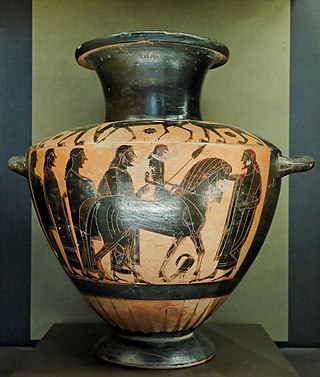
Lydos was an Attic vase painter in the black-figure style. Active between about 560 and 540 BC, he was the main representative of the "Lydos Group". His signature, ό Λυδός, ho Lydos, inscribed on two vases, is informative regarding the cultural background of the artist. Either he immigrated to Athens from the Lydian Empire of King Kroisos, or he was born in Athens as the son of Lydian parents. In any case, he learned his trade in Athens.

Epiktetos was an Attic vase painter in the early red-figure style. Besides Oltos, he was the most important painter of the Pioneer Group. He was active between 520 BC and 490 BC. His name translates as "newly acquired", which is most probably a reference to his slave status.
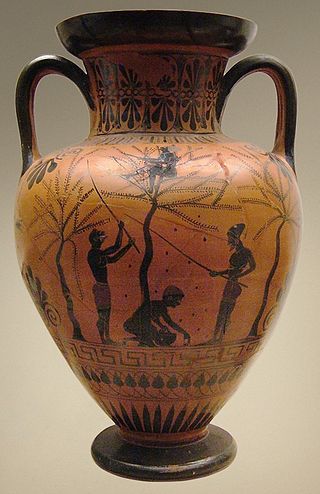
The Antimenes Painter was an Attic vase painter of the black-figure style, active between circa 530 and 510 BC.
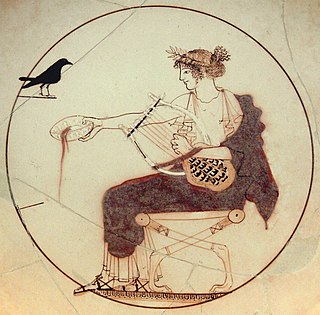
White-ground technique is a style of white ancient Greek pottery and the painting in which figures appear on a white background. It developed in the region of Attica, dated to about 500 BC. It was especially associated with vases made for ritual and funerary use, if only because the painted surface was more fragile than in the other main techniques of black-figure and red-figure vase painting. Nevertheless, a wide range of subjects are depicted.

The Amasis Painter was an ancient Greek vase painter who worked in the black-figure technique. He owes his name to the signature of the potter Amasis, who signed twelve works painted by the same hand. At the time of the exhibition, "The Amasis Painter and His World" (1985), 132 vases had been attributed to this artist.
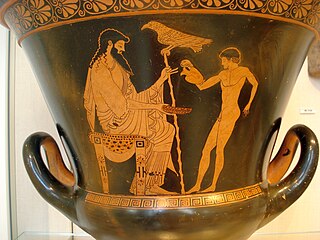
Eucharides Painter is the common nickname of an ancient Greek artist who decorated but did not sign Attic vases. Neither his real name, nor the dates of his birth and death are known. Presumably this artist was a pupil of the Nikoxenos Painter.

The Belly Amphora in the Staatliche Antikensammlungen at Munich is one of the most famous works by the Andokides Painter. The vase measures 53.5 cm high and 22.5 cm in diameter. It dates to between 520 and 510 BC and was discovered at Vulci. It was acquired by Martin von Wagner, an agent of Ludwig I of Bavaria.

Amasis was an ancient Attic potter, active in Athens between 560/550 and 530/520 BC. Amasis’s pottery workshop also employed a well-known painter, who is conventionally named the Amasis Painter after the potter, and generally considered one of the best Archaic vase painters. His works are mostly black-figure, but some red-figure vase paintings by him do occur. He and Exekias produced the first major painted amphorae with a narrative image on front and back, respectively. Famous works:

The BMN Painter was an Attic vase painter in the black-figure style, active during the third quarter of the 6th century BC.

Pamphaios was an Attic potter active around the end of the 6th century BC. Pamphaios was the successor of Nikosthenes in that artist's workshop, and thus took over from one of the most influential and creative potters of antiquity. He probably took over the workshop before 510 BC and continued the tradition of his predecessor by producing typical shapes the latter had developed, such as the Nikosthenic amphora, the Nikosthenic pyxis or the Chalkidian style cup. At times, he developed these shapes further. Unlike Nikostehenes, Pamphaios favoured painters of the red-figure style, which was at the time replacing the previously dominant technique of black-figure vase painting. He also continued to employ many of the painters that had worked for Nikosthenes, such as Oltos, Epiktetos and the Nikosthenes Painter.

The Lysippides Painter was an Attic vase painter in the black-figure style. He was active around 530 to 510 BC. His conventional name comes from a kalos inscription on a vase in the British Museum attributed to him; his real name is not known.

The Mastos Painter was a painter of ancient Greek vases. He is named for a black-figure mastos used by the art historian John Boardman to illustrate the type, which is shaped like a woman's breast.
